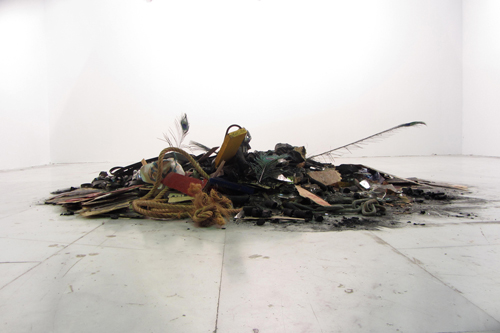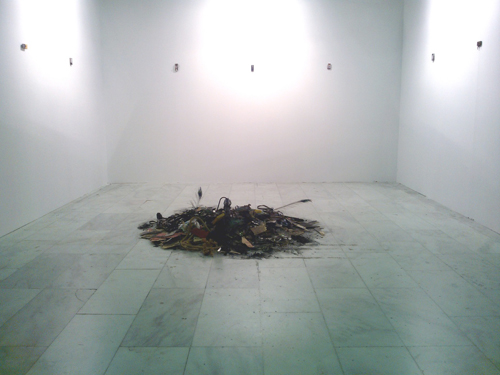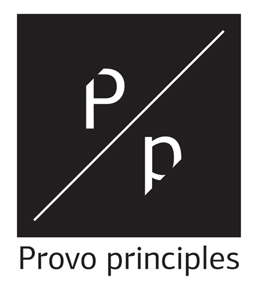PROVO PRINCIPLES is a self-managed group of artists (Andreas Voussouras, Dimitris Merantzas, Konstantinos Patsios, Aliki Pappa, Natassa Poulantza, Nikos Sepetzoglou and George Tserionis) formed in September 2011 and based in Athens, Greece. The group operates in a constantly changing world, as an “island of thought", working on projects or inviting artists, groups and theorists to participate in site specific projects." It aims to produce and promote a dialogue between art, history of art, social and political concerns with reference both in Greece and abroad.
PROVO PRINCIPLES have organized the exhibitions LOL (TAF, The Art Foundation, Athens, 2011) and POSTSCRAPS (CAMP, Contemporary Art Meeting Point, Athens, 2012). They have also presented their work at the meeting Hosted in Athens (Theater Front 2012, curated by Daily Lazy), the Systems Conference (CAMP, 2012) and at the Platform Project @ Art Athina (2015, 2013). In cooperation with the art historian John Bolis, they curated the group exhibition TRANSITION in the National Gallery of Athens (2013).
ARTISTS CVs
DIMITRIS MERANTZAS
Dimitris Merantzas was born in Athens in 1967, where he currently lives and works. 1988 He graduates, as Director of Photography, from Lycourgos Stavrakos’ Film and Television School. 1990 Receives the Fantastic Film Award for directing “Doors”, at Drama Short Film Festival. 1992 Receives distinction for his participation at Spyropoulos Foundation’s “Young Painters” contest. 1997 Accepted unanimously as a member of the Chamber of Visual Arts of Greece. He had presented his work in nine solo shows and many group shows in Greece, Turkey, Belgium, Austria.
Lives and works in Athens.
web-site: http://www.merantzas.gr
ALIKI PAPPA
Aliki Pappa was born in Athens in 1982. She studied painting at the Athens School of Fine Arts under Yiannis Psychopedis, and sculpture under Nikos Tranos (2005-2010). She also studied Theatre theory at the National and Kapodistrian University of Athens (2000-2004). She received a scholarship from the State Scholarships Foundation for a period of two years (2006-2008), as well as the State Scholarships Foundation Award (2005-06, 2006-07).
She has participated in many group exhibitions in Greece and abroad. In November 2012 she had her first solo show “Leaving Room” in Kappatos Gallery, Athens.
She lives and works in Athens.
KONSTANTINOS PATSIOS
Konstantinos Patsios was born in Athens, Greece, 1977.
He studied painting at the Athens School of Fine Arts under Yiannis Psychopedis and M. Spiliopoulos (2002 – 2007). Additional Laboratory: Sculpture, Tutor: N. Tranos (graduated with distinction).1995 – 2000 University of Piraeus- Economics and Law of the European Union.1997 “Erasmus programme” scholarship, Poitiers- France (Grand ecole de commerce).1990 Rhodes Island School of Design – Scholarship in painting by “Ziridis School” – Boston USA.
He has presented his work in nine solo exhibitions and participated in several group shows in Greece and abroad.
He lives and works in Athens.
web-site: http://www.kpatsios.com/
NATASSA POULANTZA
Natassa Poulantza was born in Hannover, Germany in 1965. She graduated (1992) from Athens Fine Art School’s Painting department while attending the Etching workshop where she studies Wood Engraving, Brass Etching and Lithography. She held postgraduate studies (1992-96) at the Munich Academy’s Painting department, on the “Meisterschuele” title, under Professor Jurgen Reipka, on a three year’s scholarship. She has presented eight solo shows and participated in many shows in Greece, Germany, Austria, Turkey, Belgium, Bosnia-Herzegovina.
She currently lives and works in Athens and Berlin.
web-site: http://www.natassa-poulantza.com/
NIKOS SEPETZOGLOU
Nikos Sepetzoglou was born in Athens in 1979. He studied (MFA) at the Inter-Departmental Postgraduate Programme: Architectural Design - Space - Culture, School of Architecture n.t.u.a. Athens (2011-2013) and (BA) painting and engraving at the Athens School of Fine Arts (2000-2005) under Yiannis Psychopedis. He has presented his work in four solo exhbitions in Athens and have participated in many group exhbitions in Greece. Alongside his artistic practice he also works in the field of research and design of prehistoric wall paintings, in collaboration with the Akrotiti Excavations, Thira (2008-2015) as well as in the re-exhibition programme of the Archaeological Museum of Thebes (2011-2015). He currently lives and works in Athens, Greece.
Solo exhibitions: 2014 I Have a Diver Down II, Elika gallery, Athens; 2011 ...O... (or a fragment) Elika gallery, Athens; 2009 Violence to waste love, Six d.o.g.s. Project Space, Athens; 2009 I Have a Diver Down… Open studio presentation, Athens.
GEORGE TSERIONIS
George Tserionis was born in 1967 in Athens. He studied at the Art school “Vakalo” and at the “Art Group and Philosophy”. He had sixteen solo exhibitions and has participated in many group exhibitions.
His works can be found in the Macedonian Museum of Contemporary Art, the Benaki Museum, the Modern Art Museum of Florina, CITIBANK Collection, Collection ALPHA BANK, ACG Art of the American College of Greece, Collection Elefsina Municipality, State Museum of Contemporary Art / Costakis Collection and private collections.
Lives and works in Athens.
web-site: http://tserionisgiorgos.blogspot.gr/
ANDREAS VOUSOURAS
Andreas Voussouras was born in Athens in 1957. From 1979 to 1982 he lived in Paris, where he studied sociology. His artistic interests apart from visual arts include radio shows and set design.Since 1990 he has collaborated with various dance and theatre companies as set designer and musical supervisor.
He has shown his work in thirteen solo exhibitions and has participated in many group exhibitions in Greece, Austria, Germany, Portugal, Turkey and USA. His works can be found in the Macedonian Museum of Contemporary Art, Thessaloniki, and private collections in Greece and Europe.
Lives and works in Athens.
Platfom
Project
@
Art
Athina
2015
EROICA
2015
Provo Principles present the installation "Εroica."
The title refers to the third, heroic symphony of Ludwig van Beethoven, which was dedicated to Napoleon Bonaparte, an ambiguous leader who likely betrayed the ideals of the French Revolution.
The installation consists of seven standard sized matchboxes. On the small space of each, the artists interfere in order to set up the grid of an allegory that directly or indirectly comments the notion of heroism. On the floor in the center of the installation, lays an aggregation of heterogeneous broken and fragmented material (woodcuts, mirror, charcoal, porcelain figurines e.t.c.) which is associated with the individual narrative on each matchbox.
The choice of matchboxes (beyond the challenge of a minimum surface of the creative space) is also related to the fact that matches were among the products (such as salt, petroleum and playing cards), that the Greek state used in order to repay the economic loan to the IFC, which lasted from the defeat in the Greco-Turkish war in 1897 until 1978.
The flammable material of the artworks implies the intention of the "heroes" to be sacrificed for their ideals and ideas, as well as the "fundamentalist" attitude that such an action might suggest˙ the explosiveness of the inner microcosm of self-baptized "heroes”, who, motivated by obsessions, stand ready to self-destruct. That extreme attitude is not reflected here monumentally but in miniaturized size, implying the end of belief in grand narratives.
"Εroica" is a project - anti project. A monument of controversy that could “self-ignite”...

EROICA
Installation detail

EROICA
Installation view

EROICA / PROVO PRINCIPLES
Platfom
Project
@
Art
Athina
2015
Eroica
2015
Provo Principles present the installation "Εroica."
The title refers to the third, heroic symphony of Ludwig van Beethoven, which was dedicated to Napoleon Bonaparte, an ambiguous leader who likely betrayed the ideals of the French Revolution.
The installation consists of seven standard sized matchboxes. On the small space of each, the artists interfere in order to set up the grid of an allegory that directly or indirectly comments the notion of heroism. On the floor in the center of the installation, lays an aggregation of heterogeneous broken and fragmented material (woodcuts, mirror, charcoal, porcelain figurines e.t.c.) which is associated with the individual narrative on each matchbox.
The choice of matchboxes (beyond the challenge of a minimum surface of the creative space) is also related to the fact that matches were among the products (such as salt, petroleum and playing cards), that the Greek state used in order to repay the economic loan to the IFC, which lasted from the defeat in the Greco-Turkish war in 1897 until 1978.
The flammable material of the artworks implies the intention of the "heroes" to be sacrificed for their ideals and ideas, as well as the "fundamentalist" attitude that such an action might suggest˙ the explosiveness of the inner microcosm of self-baptized "heroes”, who, motivated by obsessions, stand ready to self-destruct. That extreme attitude is not reflected here monumentally but in miniaturized size, implying the end of belief in grand narratives.
"Εroica" is a project - anti project. A monument of controversy that could “self-ignite”...